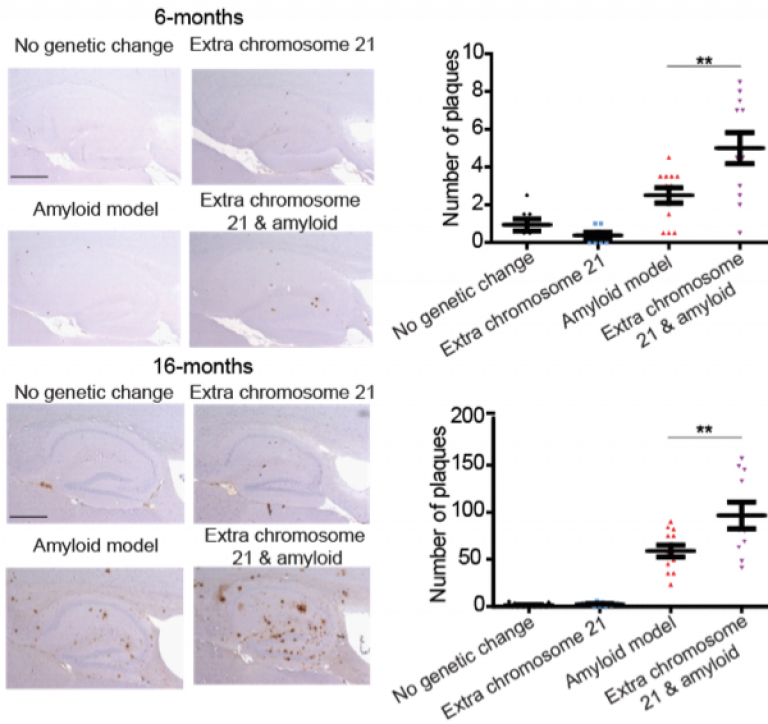
Alzheimer’s disease in people who have Down syndrome
People who have Down syndrome are at a greatly increased risk of developing Alzheimer’s disease. In recent years, because of medical advances, the life-expectancy of people who have Down syndrome has increased dramatically. On average, people who have the syndrome now live to be over sixty years of age. However, by the age of fifty all people who have Down syndrome have an extensive build-up of both amyloid-plaques and neurofibrillary tangles within their brains and by the age of sixty about two-thirds will have developed dementia (Figure 1).
 |
Down syndrome is a genetic disorder caused by an extra copy of human chromosome 21 which encodes ~ 230 genes, and is associated with a number of medical problems which are caused by the extra copies of these genes. One of these chromosome 21 genes encodes the amyloid precursor protein (APP) which is known to be fundamental in the development of AD. APP is broken-down in the brain to form Abeta, which forms amyloid plaques that trigger the development of Alzheimer’s disease. In people who have Down syndrome amyloid starts to accumulate within the brain in the late-teens and twenties and is the first change in the brain linked to the development of dementia.
Research into Alzheimer’s Disease mechanism in Down syndrome
Our goal is to understand how extra copies of genes on chromosome 21, other than APP, affect the development of Alzheimer’s disease and dementia. An extra copy of the genes on chromosome 21 profoundly affect neurodevelopment and neuronal function. Moreover, there are clinical and neuropathological differences between Alzheimer’s disease in Down syndrome and disease caused by duplication of the APP gene; indicating that trisomy of chromosome 21 modulates disease development. Our research aims to understand how disease development is altered in Down syndrome and which genes on chromosome 21 cause this. This work will help to develop and select Alzheimer’s disease treatments that can used to slow or prevent dementia onset in people who have Down syndrome. Additionally, identification of the genes that modulate the development of dementia will help us to understand how these processes happen. This information can also be used to develop new treatments to slow or prevent the development of dementia.
Recent Research finding “Genes on chromosome 21 other than APP modulate amyloid aggregation and deposition”
To study how amyloid forms in people who have Down syndrome we used two mouse models. One mouse has a change in its genes that causes the build-up of amyloid in the brain. The other mouse had an extra copy of chromosome 21 which is missing the APP gene and does not accumulate amyloid in the brain. We bred these mice together to produce mice that had a build-up of amyloid in their brain and an extra copy of chromosome 21 (but no extra APP). These mice developed more amyloid in their brains than mice without an extra copy of chromosome 21 (Figure 2). This suggests that a gene on chromosome 21 other than APP may contribute to the development of amyloid-plaques in people who have DS.
 |
We went onto show that the increased accumulation of amyloid-plaques was linked to changes in the type of Abeta being formed in the brains of mice that have an extra copy of chromosome 21. This change in the type of Abeta makes it more likely to clump together and form deposits. We are now working out how this happens and which gene on chromosome 21 causes this change. Previously scientists thought that genes on chromosome 21 other than APP were not very important to the development of amyloid plaques in people who have Down syndrome. Our work suggest that other chromosome 21 genes may be important. We hope that by understanding how these other genes effect Alzheimer’s disease development in people who have Down syndrome we can help develop new treatments to stop or slow down the development of dementia.
 Close
Close


